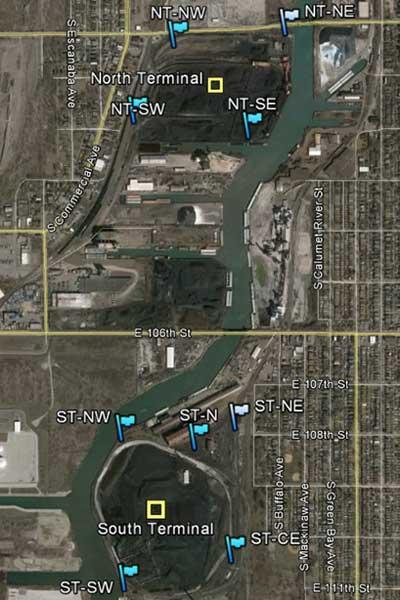Fenceline Air Monitoring at Pet Coke Storage Facilities

- What air monitoring is being done?
- How is EPA using the air monitoring data?
- When can we see the latest data?
- What are the air monitoring results so far?
- see KCBX Fenceline Air Monitoring Data for latest air monitoring data spreadsheets (summary data or raw data)
What air monitoring is being done?
EPA required KCBX to install fenceline air monitors at its pet coke facilities on the south side of Chicago at 3259 East 100th Street (North Terminal) and 10740 South Burley Avenue (South Terminal).
There are five monitors around the KCBX South Terminal (see map). Each of these monitors measures PM10 (dust) every hour, seven days a week. (PM10 is a type of particle pollution.)
KCBX also has one station at the South Terminal that collects PM10 on a filter for more detailed laboratory analysis. These filters are collected twice per week and used for a 24-hour sample; the filters are analyzed for toxic metals and other elements.
KCBX has installed a weather station at the South Terminal to measure wind speed and wind direction. This will help identify the source of the dust. EPA will compare the monitoring data to wind direction to determine the source of the pollution.
There were four particulate matter monitors and one meteorological station at the KCBX North Terminal, from 2014 through 2015, while the facility was in operation. In a letter dated December 23, 2015, EPA approved KCBX’s request to cease ambient air monitoring at the North Terminal. Petcoke has been removed from the KCBX North Terminal since summer 2015. Ambient air monitoring data for the North Terminal ended on January 4, 2016.
In a letter dated December 23, 2015, EPA approved KCBX’s request to cease ambient air monitoring at the North Terminal. Petcoke has been removed from the KCBX North Terminal since summer 2015. Ambient air monitoring data for the North Terminal ended on January 4, 2016.
In a letter dated March 23, 2016, EPA conditionally approved KCBX’s request to alter the monitoring requirements at the South Terminal. Ambient air monitoring continues at the South Terminal.
In a letter dated February 13, 2017, EPA approved KCBX’s request to terminate the monitoring requirements at the South Terminal. Ambient air monitoring continues at the South Terminal under the City of Chicago Regulations.
How is EPA using the air data?
EPA is compared the PM10 data to EPA’s National Ambient Air Quality Standard (NAAQS). The PM10 standard is exceeded when the 24-hour average is higher than 150 micrograms per cubic meter.
EPA was tracking the data to see whether the NAAQS is exceeded at any of the KCBX fenceline air monitors. If NAAQS are exceeded, EPA may use its statutory authorities to take action to maintain air quality.
EPA can do chemical analysis of air samples to help understand what pollutants are found in the particles. EPA can determine the amount of toxic metals in the samples. The wind direction information from the weather stations may indicate which source is responsible for emitting the PM10 and toxic metals.
EPA can analyze the toxic metals results to estimate how breathing these pollutants might affect people’s health over the long-term. Consideration was done for the potential long-term risks of cancer and other chronic health effects, including respiratory and neurological effects.
EPA does not have air quality standards for air toxics. Instead we use the best available information about pollutant health effects to establish health-based comparison levels. We will evaluate long-term metals concentrations relative to these comparison levels. If there is a potential health concern with toxic metals, then EPA will take steps to identify and address the problem.
See also: Hazardous Air Pollutants
When can we see the latest data?
No new data is being posted at this time. The facility is only sharing raw data with the City of Chicago at this time.
What monitoring results were seen?
KCBX’s air monitoring network started operating on Feb. 18, 2014. Most of the PM10 measurements are well below the NAAQS. However:
- On April 12, 2014, there was one 24-hour period higher than 154 micrograms per cubic meter at the North Terminal northeast site (NE).
- On May 8, 2014, the northeast site at the North Terminal and the northeast site at the South Terminal both had a 24-hour average concentration higher than 154 micrograms per cubic meter.
- On February 14, 2015, the 24-hour average concentration at the North Terminal southeast site (SE) was 175 micrograms per cubic meter.
Toxic metals should be evaluated after several months of data have been reported. Findings in southeast Chicago show that most metals are well below EPA's health screening levels for long-term exposure. One exception is manganese, which is near the screening level at the North Terminal northeast site. EPA will continue to track the toxic metals results. We will investigate possible sources of manganese in Southeast Chicago.
KCBX Fenceline Air Monitoring Data presents spreadsheets with summary data of PM10 measurements and also spreadsheets with raw data.
